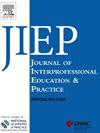创新课程对医学生跨专业实习准备的影响
Q3 Social Sciences
Journal of Interprofessional Education and Practice
Pub Date : 2025-08-08
DOI:10.1016/j.xjep.2025.100762
引用次数: 0
摘要
跨专业教育(IPE)被世界卫生组织定义为“来自两个或两个以上专业的学生相互了解、相互学习和相互学习”的过程,它被公认为是改善协作护理和患者治疗效果的重要贡献者。然而,目前缺乏在临床环境中促进IPE的具体干预措施的有力证据。我们课程的目标是让医学生接触到IPE的价值,并提高他们对其他非医生医疗保健专业人员在真实临床环境中的角色和责任的知识和态度。学生们确定了两名参与他们负责的病人护理的非医师医疗保健专业人员,在临床环境中观察他们,并采访他们。学生们完成了课前和课后调查,包括内布拉斯加州跨专业教育态度量表(NIPEAS)。使用Wilcoxon符号秩检验来比较反应并解释配对数据。在活动前后比较了学生正确识别作者确定的合适合作者的能力。所有轮班学生都在结构化的汇报会议上写了个人和小组的反思,会议主持人记录了整个小组会议的亮点。每次汇报会议至少有四名非医师保健专业人员参加,他们讲述了自己的角色,并回答了医学生提出的任何问题。在定性分析中采用了持续的比较多审稿人程序,以制定和确定主要主题。与课前相比,在课程后调查的19个nipea项目中,有9个项目有统计学上的显著改善。学习IPE课程后,学生能够更好地在病人护理中找到合适的合作者。为了探索改善患者护理和结果的潜在方法,定性分析从跨专业教育课程实施后的汇报会议中确定了关键主题。这些主题包括专业知识的多样性、合作护理、相互尊重、全面或整体护理以及对角色的更深入理解。其他主题强调了改善沟通、有利于学习、创新、包容的环境以及这些过程中固有挑战的重要性。本文章由计算机程序翻译,如有差异,请以英文原文为准。
Impact of an innovative curriculum on medical student preparedness for interprofessional practice
Interprofessional education (IPE), defined by the World Health Organization as a process that “occurs when students from two or more professions learn about, from, and with each other”1 is well-established as an important contributor to improving collaborative care and patient outcomes. However, strong evidence for specific interventions to foster IPE in the clinical setting is currently lacking. The goals of our curriculum are to expose medical students to the value of IPE and improve their knowledge about and attitudes towards the roles and responsibilities of other non-physician healthcare professionals in a real clinical environment.
Students identified two non-physician healthcare professionals involved in the care of patients they were responsible for, observed them in the clinical environment, and interviewed them. Students completed a pre- and post-curriculum survey including the Nebraska Interprofessional Education Attitudes Scale (NIPEAS). Wilcoxon signed rank test was used to compare responses and account for paired data. Student ability to correctly identify appropriate collaborators, as determined by the authors, was compared before and after the activity. All rotating students wrote individual and small group reflections during structured debrief sessions, and the session moderator documented highlights of these whole group sessions. Each debrief session was attended by at least four non-physician healthcare professionals who spoke about their roles and answered any questions from the medical students. A constant comparative multi-reviewer process was utilized for qualitative analysis to develop and finalize major themes.
Statistically significant improvements occurred in 9 of 19 NIPEAS items in the post-curriculum survey compared to pre-curriculum. Following the IPE curriculum, students were better able to identify appropriate collaborators in patient care. To explore potential ways to improve patient care and outcomes, the qualitative analysis identified key themes from the debrief sessions following the implementation of the interprofessional education curriculum. These themes included the diversity of expertise, collaborative care, mutual respect, comprehensive or holistic care, and a deeper understanding of roles. Additional themes highlighted the importance of improved communication, an environment conducive to learning, innovation, inclusivity, and the challenges inherent in these processes.
求助全文
通过发布文献求助,成功后即可免费获取论文全文。
去求助
来源期刊

Journal of Interprofessional Education and Practice
Social Sciences-Education
CiteScore
1.60
自引率
0.00%
发文量
80
期刊介绍:
Journal of Interprofessional Education & Practice, a quarterly online-only journal, provides innovative ideas for interprofessional educators and practitioners through peer-reviewed articles and reports. Each issue examines current issues and trends in interprofessional healthcare topics, offering progressive solutions to the challenges facing the profession. The Journal of Interprofessional Education & Practice (JIEP) is affiliated with University of Nebraska Medical Center and the official journal of National Academies of Practice (NAP) and supports its mission to serve the public and the health profession by advancing education, policy, practice & research.
 求助内容:
求助内容: 应助结果提醒方式:
应助结果提醒方式:


